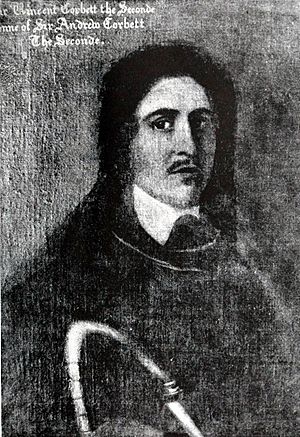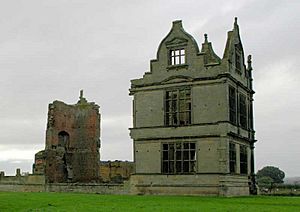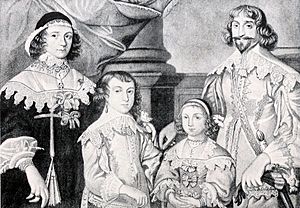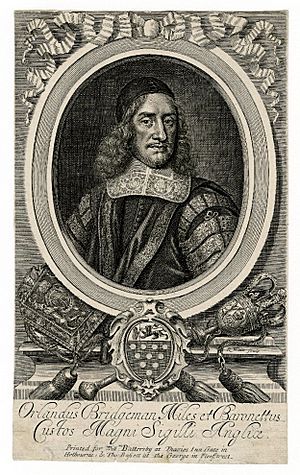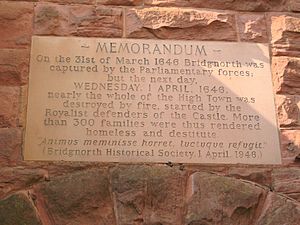Sir Vincent Corbet, 1st Baronet facts for kids
Sir Vincent Corbet, 1st Baronet (born June 13, 1617 – died December 28, 1656) was an English lawyer and politician. He was a Member of Parliament for Shropshire in 1640. During the English Civil War, he fought on the side of the King, known as the Royalists or Cavaliers.
Contents
Sir Vincent's Family History
Vincent Corbet was the son of Sir Andrew Corbet of Moreton Corbet, Shropshire. His family, the Corbets of Shropshire, had been very powerful and important. However, they had faced some tough times with money and family issues.
Vincent's grandfather, also named Sir Andrew Corbet, was a famous soldier and politician. But after he died in 1578, his two older sons passed away without sons of their own. One of them, Richard, also left behind a lot of debt. Vincent's father, Sir Andrew, worked hard to fix the family's money problems.
Vincent's mother was Elizabeth Boothby. Her mother, Judith Austin, was a wealthy widow. By marrying Andrew to Elizabeth, Sir Vincent's grandfather hoped to get Judith to help with the family's finances.
Sir Andrew and Lady Elizabeth had many children, including seven sons and nine daughters. Their first son and heir was named Vincent, after his grandfather. Sir Andrew became a well-known Member of Parliament. He started out supporting King James I, but later strongly disagreed with King Charles I's idea of absolute power.
Family Connections
This family tree shows how Sir Vincent Corbet was related to other Corbets who were involved in the Civil War.
| Sir Vincent Corbet: his ancestry and relatives | ||||||||||||||||||||||||||||||||||||||||||||||||||||||||||||||||||||||||||||||||||||||||||||||||||||||||||||||||||||||||||||||||||||||||||||||||||||||||||||||||||||||||||||||||||||||||||||||||||||||||||||||||||||||||||||||||||||||||||||||||||||||||||||||||||||||||||||||||||||||||||||||||||||||||||||||||||||||||||||||||||||||||||||||||||||||||||||||||||||||||||||||||||||||||||||||||||||||||||||||||||||||||||||||||||||||||||||||||||||||||||||||||||||||||||||||||||||||||||||||||||||||||||||||||||||||||||||||||||||||||||||||||||||||||||||||||||||||||||||||||||||||||||||||||||||||||||||||||||||||||||||||||||||||||||||||||||||||||||||||||||||||||||||||||||||||||||||||||||||||||||||||||||||||||||||||||||||||||||||||||||||||||||||||||||||||||||||||||||||||||||||||||||||||||||||||||||||||||||||||||||||||||
|---|---|---|---|---|---|---|---|---|---|---|---|---|---|---|---|---|---|---|---|---|---|---|---|---|---|---|---|---|---|---|---|---|---|---|---|---|---|---|---|---|---|---|---|---|---|---|---|---|---|---|---|---|---|---|---|---|---|---|---|---|---|---|---|---|---|---|---|---|---|---|---|---|---|---|---|---|---|---|---|---|---|---|---|---|---|---|---|---|---|---|---|---|---|---|---|---|---|---|---|---|---|---|---|---|---|---|---|---|---|---|---|---|---|---|---|---|---|---|---|---|---|---|---|---|---|---|---|---|---|---|---|---|---|---|---|---|---|---|---|---|---|---|---|---|---|---|---|---|---|---|---|---|---|---|---|---|---|---|---|---|---|---|---|---|---|---|---|---|---|---|---|---|---|---|---|---|---|---|---|---|---|---|---|---|---|---|---|---|---|---|---|---|---|---|---|---|---|---|---|---|---|---|---|---|---|---|---|---|---|---|---|---|---|---|---|---|---|---|---|---|---|---|---|---|---|---|---|---|---|---|---|---|---|---|---|---|---|---|---|---|---|---|---|---|---|---|---|---|---|---|---|---|---|---|---|---|---|---|---|---|---|---|---|---|---|---|---|---|---|---|---|---|---|---|---|---|---|---|---|---|---|---|---|---|---|---|---|---|---|---|---|---|---|---|---|---|---|---|---|---|---|---|---|---|---|---|---|---|---|---|---|---|---|---|---|---|---|---|---|---|---|---|---|---|---|---|---|---|---|---|---|---|---|---|---|---|---|---|---|---|---|---|---|---|---|---|---|---|---|---|---|---|---|---|---|---|---|---|---|---|---|---|---|---|---|---|---|---|---|---|---|---|---|---|---|---|---|---|---|---|---|---|---|---|---|---|---|---|---|---|---|---|---|---|---|---|---|---|---|---|---|---|---|---|---|---|---|---|---|---|---|---|---|---|---|---|---|---|---|---|---|---|---|---|---|---|---|---|---|---|---|---|---|---|---|---|---|---|---|---|---|---|---|---|---|---|---|---|---|---|---|---|---|---|---|---|---|---|---|---|---|---|---|---|---|---|---|---|---|---|---|---|---|---|---|---|---|---|---|---|---|---|---|---|---|---|---|---|---|---|---|---|---|---|---|---|---|---|---|---|---|---|---|---|---|---|---|---|---|---|---|---|---|---|---|---|---|---|---|---|---|---|---|---|---|---|---|---|---|---|---|---|---|---|---|---|---|---|---|---|---|---|---|---|---|---|---|---|---|---|---|---|---|---|---|---|---|---|---|---|---|---|---|---|---|---|---|---|---|---|---|---|---|---|---|---|---|---|---|---|---|---|---|---|---|---|---|---|---|---|---|---|---|---|---|---|---|---|---|---|---|---|---|---|---|---|---|---|---|---|---|---|---|---|---|---|---|---|---|---|---|---|---|---|---|---|---|---|---|---|---|---|---|---|---|---|---|---|---|---|---|---|---|---|---|---|---|---|---|---|---|---|---|---|---|---|---|---|---|---|---|---|---|---|---|---|---|---|---|---|---|---|---|---|---|---|---|---|---|---|---|---|---|---|---|---|---|---|---|---|---|---|---|---|---|---|---|---|---|---|---|---|---|---|---|---|---|---|---|---|---|---|---|---|---|---|---|---|---|---|---|---|---|---|---|---|---|---|---|---|---|---|---|---|---|---|---|---|---|---|---|---|---|---|---|---|---|---|---|---|---|---|---|---|---|---|---|---|---|---|---|---|---|---|---|---|---|---|---|---|---|---|---|---|---|---|---|---|---|---|---|---|---|---|---|---|---|---|---|---|---|---|---|---|---|---|---|---|---|---|---|---|---|---|---|---|---|---|
|
||||||||||||||||||||||||||||||||||||||||||||||||||||||||||||||||||||||||||||||||||||||||||||||||||||||||||||||||||||||||||||||||||||||||||||||||||||||||||||||||||||||||||||||||||||||||||||||||||||||||||||||||||||||||||||||||||||||||||||||||||||||||||||||||||||||||||||||||||||||||||||||||||||||||||||||||||||||||||||||||||||||||||||||||||||||||||||||||||||||||||||||||||||||||||||||||||||||||||||||||||||||||||||||||||||||||||||||||||||||||||||||||||||||||||||||||||||||||||||||||||||||||||||||||||||||||||||||||||||||||||||||||||||||||||||||||||||||||||||||||||||||||||||||||||||||||||||||||||||||||||||||||||||||||||||||||||||||||||||||||||||||||||||||||||||||||||||||||||||||||||||||||||||||||||||||||||||||||||||||||||||||||||||||||||||||||||||||||||||||||||||||||||||||||||||||||||||||||||||||||||||||||
Early Life and Schooling
Vincent Corbet was born on June 13, 1617, and baptized at Moreton Corbet on July 13. He started studying at Queen's College, Oxford, in 1634. After his father died, he began studying law at Lincoln's Inn in 1637.
Sir Vincent's Role in the Civil War
War Begins
In April 1640, Vincent Corbet was chosen to be a Member of Parliament for Shropshire. He gained military experience fighting for the King in a war against the Scottish Presbyterians. Because of his support, the King made him a Baronet of Moreton Corbet in January 1642. A Baronet is a special title, like a knight, that can be passed down in the family.
In the summer of 1642, both Parliament and the King started getting their armies ready. Corbet was put in charge of getting Shropshire ready for the King. He made his home, Moreton Corbet Castle, a stronghold for the King's side. Meanwhile, his cousin, Sir John Corbet, was sent by Parliament to take control of the local army.
The Royalist army took over Shrewsbury from September 20 to October 12, 1642. They faced little resistance. Sir Francis Ottley, who was now a knight, was left in charge of the town.
Forming the Dragoons
In December, Sir Vincent Corbet and other Shropshire leaders decided to create a regiment of dragoons. Dragoons were soldiers who rode horses but fought on foot. They hoped to recruit a thousand men. At first, only 60 men joined, but Corbet and his men were soon called to fight in Cheshire in January.
First Battle Experience
Chester was a very important place for the Royalists because it allowed them to get supplies from Ireland. However, most of Cheshire supported Parliament. There were problems with communication and rivalries among the Royalist leaders. Orlando Bridgeman, a judge in Chester, complained that Corbet had refused to move his small force further into Cheshire.
Corbet joined forces with Sir Thomas Aston, hoping for more soldiers to arrive. On January 28, 1643, they approached Nantwich, thinking it was friendly. But they found about 140 Parliamentarian soldiers there. After trying to attack the town, they pulled back. Then, they ran into the main Parliamentarian army led by Sir William Brereton. They fought their way through the battle. Corbet and Aston both said it was a draw, but Corbet asked for surgeons, not more soldiers.
Brereton said that Corbet's dragoons "ran awaye withoute ever giving fire." He thought Aston was hurt and that both Corbet and Aston were captured briefly but escaped. People argued about what really happened. Some called the Royalist leaders cowards, but others saw their actions as smart. Corbet's choice not to advance earlier had probably saved his small group from being trapped.
War Campaigns
Corbet's force grew bigger and more experienced. They fought regularly around Whitchurch, though they lost many men.
As they gained experience, Corbet's soldiers became more effective. Brereton even noted that "the Shropshire horse and Dragoons came on with great resolution and boldness." In July, Corbet was allowed to raise a thousand infantry soldiers (soldiers who fight on foot). This larger force helped the Royalist efforts in the area.
Parliament was also getting stronger in Shropshire. They formed a committee in February, which included two Corbets: Sir John Corbet and Robert Corbet, Sir Vincent's cousin, both on the Parliamentarian side. By late summer, Parliament gained a foothold in Shropshire at Wem. Both Wem and Nantwich held strong against Royalist attacks.
In early 1644, Prince Rupert, a famous Royalist commander, came with a large cavalry force. He took over from Ottley and started to win back Shropshire and Cheshire. However, Rupert was often called away to other battles, and Parliamentarians would gain ground when he was gone.
Parliament Wins
Moreton Corbet Castle, Sir Vincent's home, was damaged many times during the Civil War. It was a key point between Wem and Shrewsbury. In September 1644, the castle fell to a small group from Wem. A Dutch soldier named William Reinking led the attack. Five attackers surprised the castle, throwing hand grenades to confuse the defenders. The castle was captured easily, and a lot of weapons were taken.
By the end of the year, groups of "clubmen" started forming in Shropshire. These were local people who organized to protect themselves from soldiers who were stealing and demanding money.
In February 1645, Prince Maurice took some soldiers from Shrewsbury to fight in Cheshire. The Parliamentarian committee saw their chance. Sir Vincent Corbet was away fighting, so he avoided being captured. Parliamentarians surprised a meeting of Royalist leaders at Apley Hall and took them prisoner. The next day, Parliamentarian soldiers took over Shrewsbury with little fighting. They did not loot the town, as they believed the townspeople supported Parliament.
Corbet's infantry, the Shrewsbury Foot, fought at the important Battle of Naseby later that year. In May 1646, Sir Vincent was at the siege of Bridgnorth. The Royalist defenders retreated into the castle, and the town was burned to the ground to keep it from the enemy. This left over 300 families homeless. The Royalists in the castle eventually surrendered. Sir Vincent, like most others, chose peace, but it came at a high cost.
After the War
After the war, Corbet had to pay a large fine to get his seized estates back. The fine was about £2,822, which was a lot of money, especially since he already had debts of £9,200. Even with a discount, he was still in a lot of debt. Family historians say his later years were "greatly embittered by debt." It was also hard for him to provide money for his five daughters.
Despite his money problems, Corbet was said to be ready to help King Charles II take Shrewsbury in 1654. However, he did not actively support a Royalist uprising in March 1655.
Death and Legacy
Sir Vincent Corbet died at age 39 in London on December 28, 1656. His body was brought back to Moreton Corbet and buried there in January 1657.
Before he died, Corbet put his estates under the care of trustees: his brother-in-law, Francis Thornes; his younger brother, Arthur; and a friend, Richard Baddeley. Since his oldest son, Sir Vincent Corbet, 2nd Baronet, was still very young (around 14 or 15), the trustees managed the estates. Sir Vincent had set aside money from his lands to provide marriage funds for his daughters.
However, Francis Thornes started to manage the estates in a way that upset the other trustees and the Corbet family. They went to court in 1659, saying Thornes was using the estates for his own gain and turning the young Vincent against his mother. The problem was not easily solved. Thornes even arranged for his own daughter, Elizabeth, to marry the young Baronet, her cousin.
Marriage and Children
Sir Vincent Corbet married Sarah Monson. Her father, Sir Robert Monson, was a wealthy landowner. Lady Sarah Corbet lived much longer than her husband. She was given the special title of Viscountess Corbet for life in 1679. Later, she married Sir Charles Lee. She died in 1682.
Sir Vincent and Lady Sarah Corbet had several children, mostly born during or right after the Civil War:
- Andrew Corbet died when he was young.
- Sir Vincent Corbet, 2nd Baronet, married Elizabeth Thornes. He died from smallpox in London in 1681.
- Sir Vincent Corbet, 3rd Baronet, his son, died at age 18 in 1688 while studying at Oxford. When he died, the Baronet title ended because he had no children.
- Robert Corbet became a lawyer. He died in London in 1678.
- Elizabeth Corbet married Sir John Bolles, a wealthy landowner.
- Mary Corbet married Sir Thomas Estcourt in 1678. He was a Member of Parliament.
- Sarah Corbet married Phineas Fowke, a doctor.
- Diana Corbet married a Mr. Roche.
- Rachell Corbet was the only daughter who did not marry. She was buried in Shrewsbury in 1706.


